The annual SiFest photography festival takes place this weekend in Savignano, Italy. I’ll be showing work in the group show ‘Sin_tesis: paesaggio, industria, società’, which also features photographs by Guido Guidi, Martin Parr, Andrew Phelps, Mark Steinmetz, Raimond Wouda and Marco Zanta.
The exhibition is a result of the Savignano Immagini photographic campaign (from 2009 to date). This collective exhibition is a kind of festival inside the festival: photographers like Mark Steinmetz from the USA, Andrew Phelps from Austria, Martin Parr and Simon Roberts from the UK, Raimond Wouda from Holland, Guido Guidi and Mark Zanta from Italy will be there. They have all been invited to measure themselves with the Savignano territory and to study its interactions and transformations between landscape, industry and society. The result is a very close study on the environmental and economic network that also reflects itself on national scale. The Sin_tesis catalogue will be presented in September with a Gerry Badger’s critical text.
The exhibition is curated by Stefania Rössl and Massimo Sordi.
For more information visit the Sifest website here and there’s an exhibition map here.
Don’t miss the next POC meeting in Vevey, Switzerland. This anniversary workshop is being held in parallel with the Images Festival.
All events will take place at Local d’Art Contemporain, 8 Ruelle des Anciens-Fossés, Vevey, Switzerland. POC.
Here is the public program of our Vevey meeting. Hope to see you all there…
Sept 8, 11:30, Welcome BBQ!
Sept 9. 11:30, Come and Share the Brunch with us!
Sept 9, 16:00 -18:00: Sofa discussions: Two photographers share their work and thoughts with each other and with the public. Today: Brian Ulrich with Charles Fréger, Seba Kurtis with Petros Efstathiadis
Sept 10, 10:00 -12:00: Public working sessions: POC members are sharing their personal and collective projects, concerns and challenges. Public welcome.
Sept 10, 16:00-18:00: Sofa discussions: Two photographers share their work and thoughts with each other and with the public. Today: Anita Witek with Charlott Markus, Simon Roberts with Andrew Phelps
Sept 11, 11:00-12:00: Public working sessions: POC members are sharing their personal and collective projects, concerns and challenges. Public welcome.
Sept 21, 19:00: “Pocktails” evening!
The participating POC photographers are:
Patricia Almeida
Mathieu Bernard-Reymond
Bert Danckaert
Götz Diergarten
Cassander Eeftinck Schattenkerk
Petros Efstathiadis
Charles Fréger
Marina Gadonneix
Peter Granser
Yann Gross
Matthias Koch
Seba Kurtis
Charlott Markus
Loan Nguyen
Andrew Phelps
Augustin Rebetez
Simon Roberts
Brian Ulrich
Anita Witek
Visit our facebook page with more details here.
A set of prints from We English will on be on show as part of the 19th edition of the .
This year”s festival, called Terra Cognita, transcends photographic genres to sketch a picture of the relation between man and nature, on the basis of the
work of 115 photographers. Terra Cognita is about the experience of nature, in all its manifestations, from tactile, living and breathing nature, to the nature of our thoughts, its dreamed and fantastic incarnations. Although man sometimes seems to be hardly present in the photos, he has unmistakably left his stamp on it. In all this work the landscape reveals the emotions and thoughts that the photographer has projected on it. The diverse and complex ways in which we see and experience landscapes – the nature in our genes and our minds – echo through the breadth of Terra Cognita. From timeless black and white to conceptual or computer generated, the blending of genres is total. Like nature itself, this is an exhibition not just to be seen, but to be experienced.
You can watch a short trailer of the festival exhibition here and view the festival magazine .
The official opening of the main exhibition at Museum Belvédère, Heerenveen, The Netherlands is on Saturday, September 1, 2012, 4 pm.
The World in London is an ambitious outdoor photography project for 2012 by The Photographers’ Gallery, showing London’s diversity and photography’s unique role in capturing the human form.
Over the past three years the gallery have commissioned acclaimed and emerging British and international photographers to take portraits of Londoners of all ages and from all walks of life. Each portrait is unique in its composition, setting and style.
Coinciding with the London 2012 Olympic and Paralympic Games, this project brings together 204 portraits of 204 Londoners, each originating from one of the competing nations. Mine depicts the Reverend David Haokip, Vicar of St George’s Parish Church in East Ham, and an exile from Burma (see above).
The World in London celebrates London as a place where individuals from all parts of the world live side by side, each of them contributing to make London the unique city it is.
All photographs will feature on the project’s website here, which includes background stories on each of the participating Londoners. You can listen to David talking about his life here.
You can see a photograph of David and I at the launch in Victoria Park this morning via Getty images here.
The prints will also be on show at Park House, 453 – 497 Oxford Street, London, W1: 27 July – 30 August 2012.
An exhibition of my series, Pierdom, at The Photographers’ Gallery, Print Room,
in London. More details here.
My touring exhibition of We English heads to Wales, opening this weekend at the Third Floor Gallery in Cardiff.
Opening night preview: Friday, 20 July, 7pm.
Prior to that we’ll be heading to Daniel Meadows’ exhibition ‘Early Photographic Works‘ at Ffotogallery.
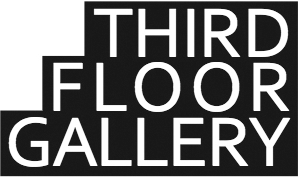
Third Floor Gallery is an independent charitable gallery run by photographers Joni Karanka, Maciej Dakowicz, Bartosz Nowicki and a group of committed volunteers. Located in a period building a stone’s throw away from Cardiff’s bustling waterfront and the Millennium Centre, Third Floor Gallery shows the most exciting national and international contemporary photography.
Uncommon Ground is the title of Flowers Gallery’s summer show, curated by Chris Littlewood, and is an exploration of environmental interventions in contemporary photography.
“Inspired by the work of Keith Arnatt and Gabriel Orozco, this exhibition aims to obscure the intersection between photographs of observed reality and artistically altered reality. Here, environment is taken in its broadest sense: natural ecosystems, urban and suburban space, domestic interiors, industrial landscapes and even political arenas.
Work by the following artists will be on show- PETER AINSWORTH, EDWARD BURTYNSKY, CHRIS ENGMAN, ANDREA GALVANI, ANDY GOLDSWORTHY, SCARLETT HOOFT GRAAFLAND, NADAV KANDER, JASON LARKIN, ALASTAIR LEVY, JAEHYO LEE, TOM LOVELACE, JOHN MACLEAN, ROBERT POLIDORI, SIMON ROBERTS, AARON SCHUMAN and DAVID SPERO.
More information available to download here.
Image above Higgs Ocean #12, 2010 © Andrea Galvani
I am exhibiting a new body of work as part of the London Festival of Photography running throughout June. Let This Be A Sign is on show at the Swiss Cottage Gallery and explores the economic, political and social effects of the recent UK recession.
Here are some installation shots-
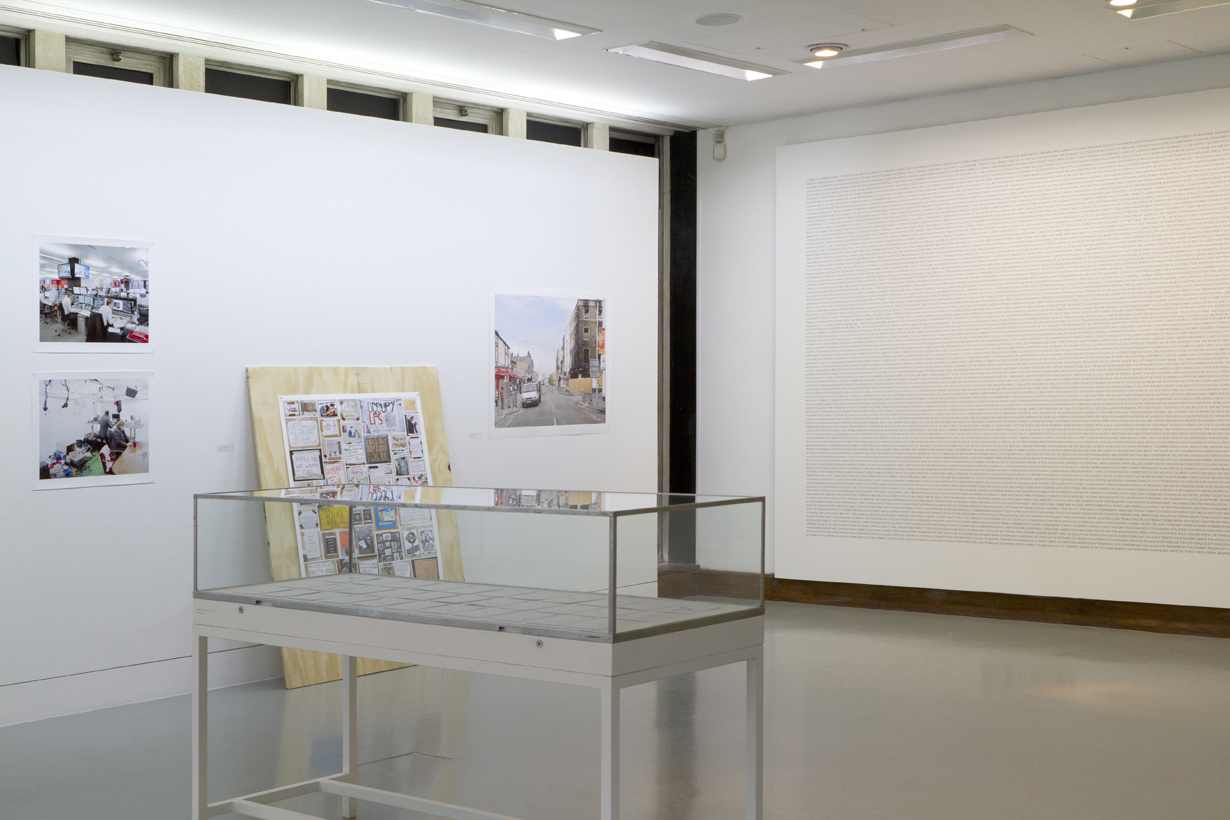
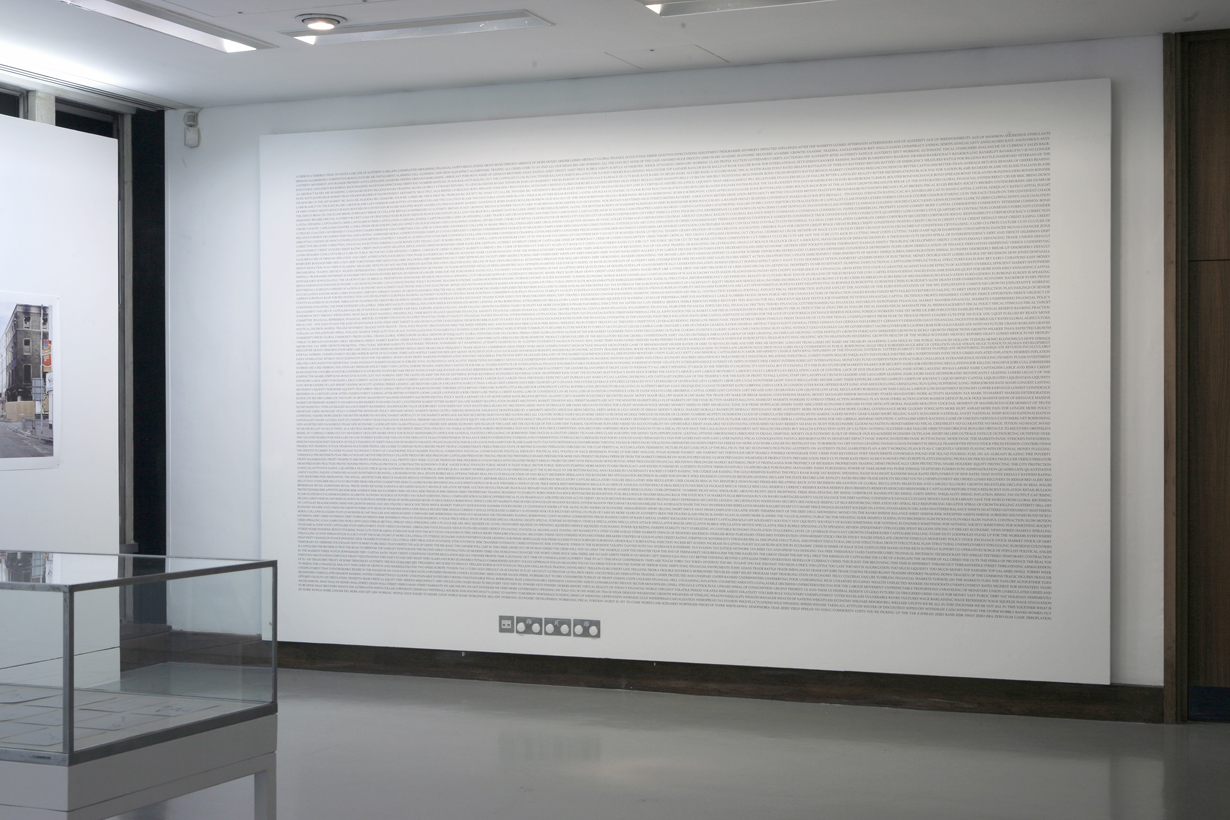
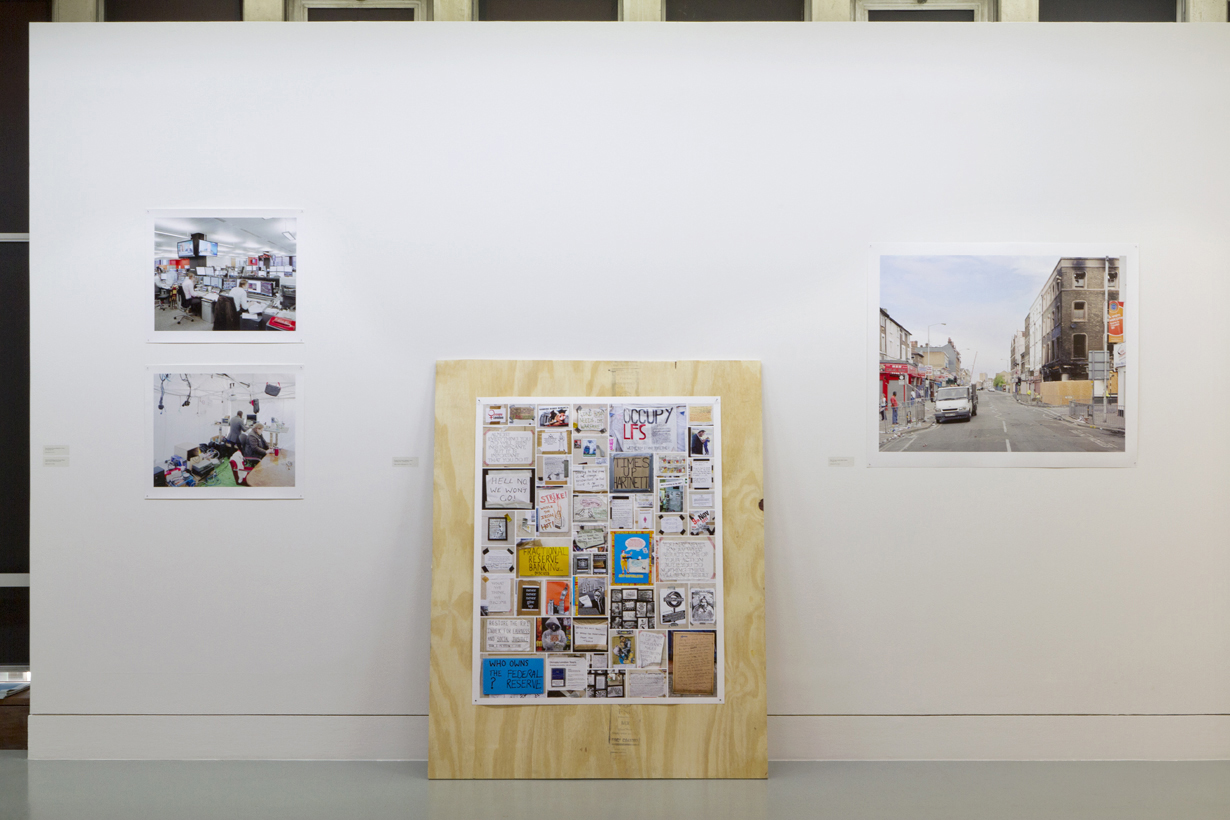
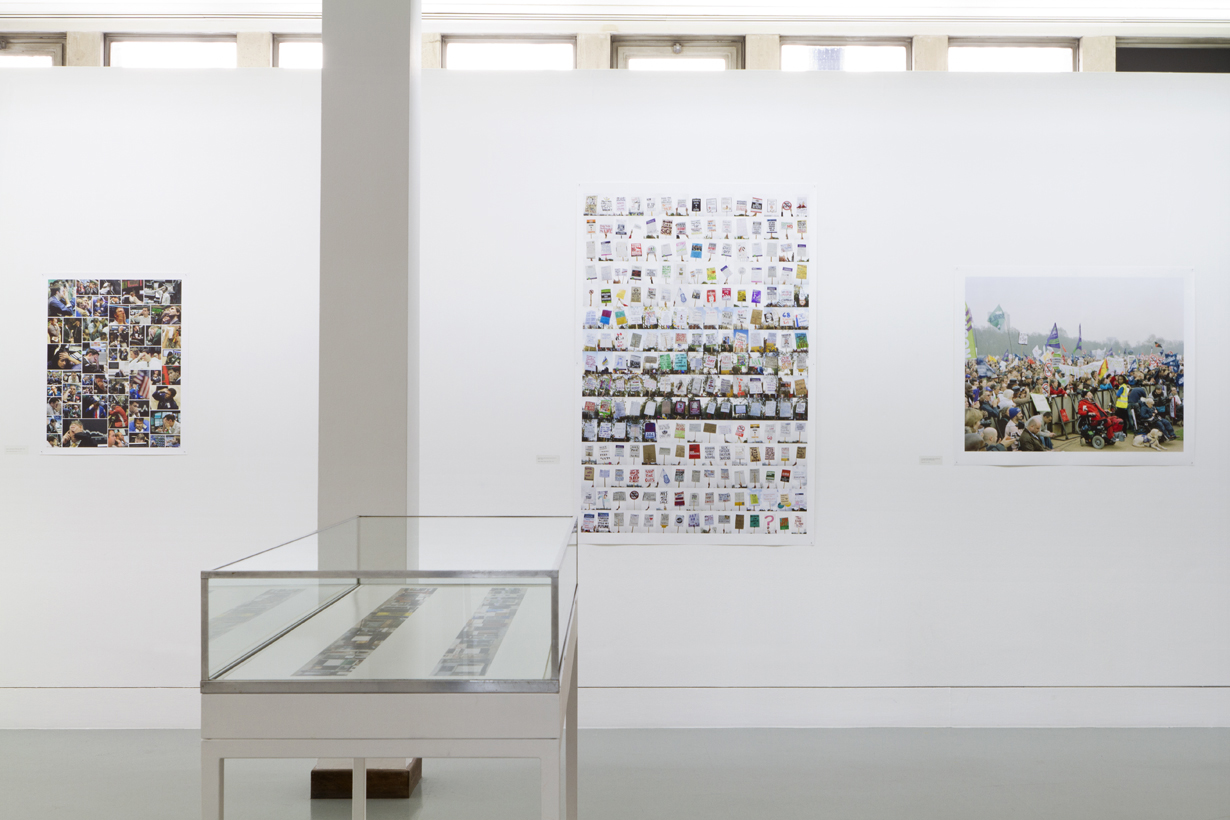
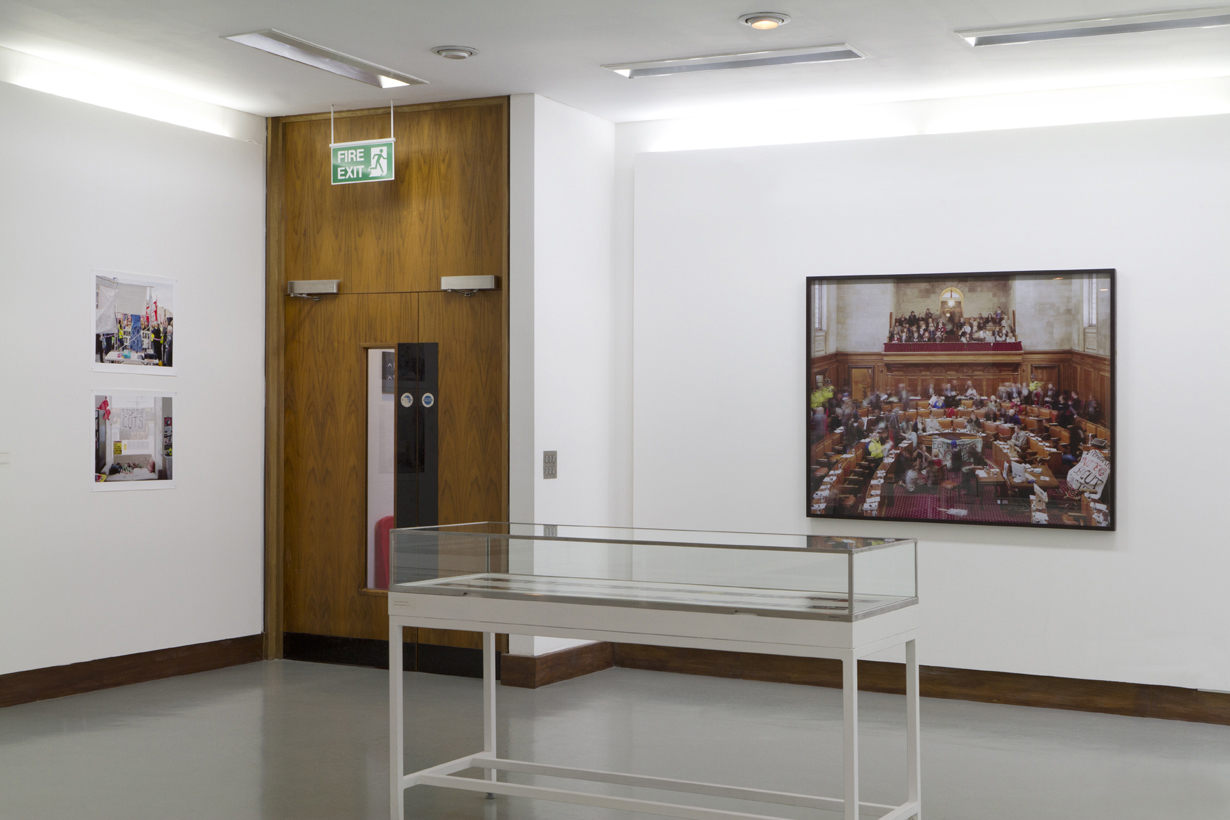
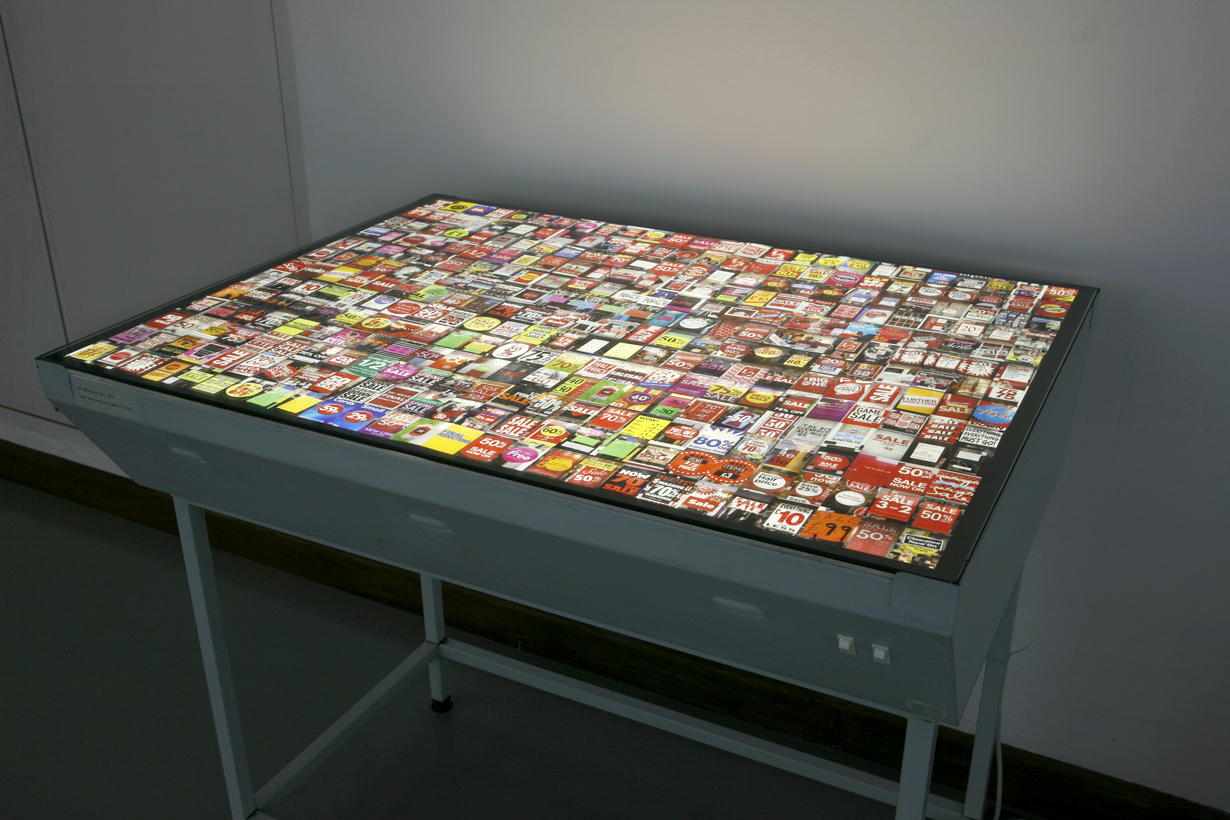
Alongside the exhibition, a participatory space has been set up where visitors are invited to share their thoughts and experiences. Why not get involved?
If you would like the opportunity to share your experiences of the recession and its effects, you can leave a message on the Public Wall in the gallery, or via twitter using the hashtag #LetThisBeASign.
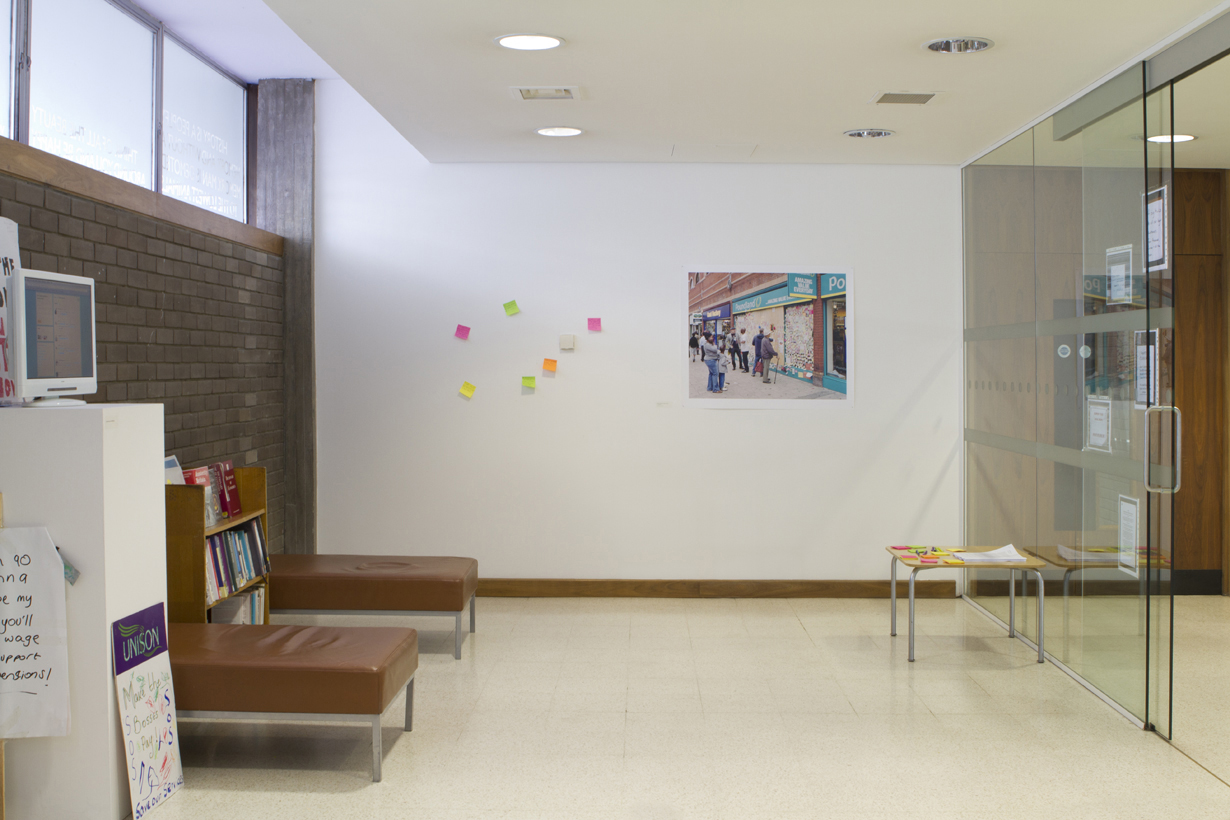
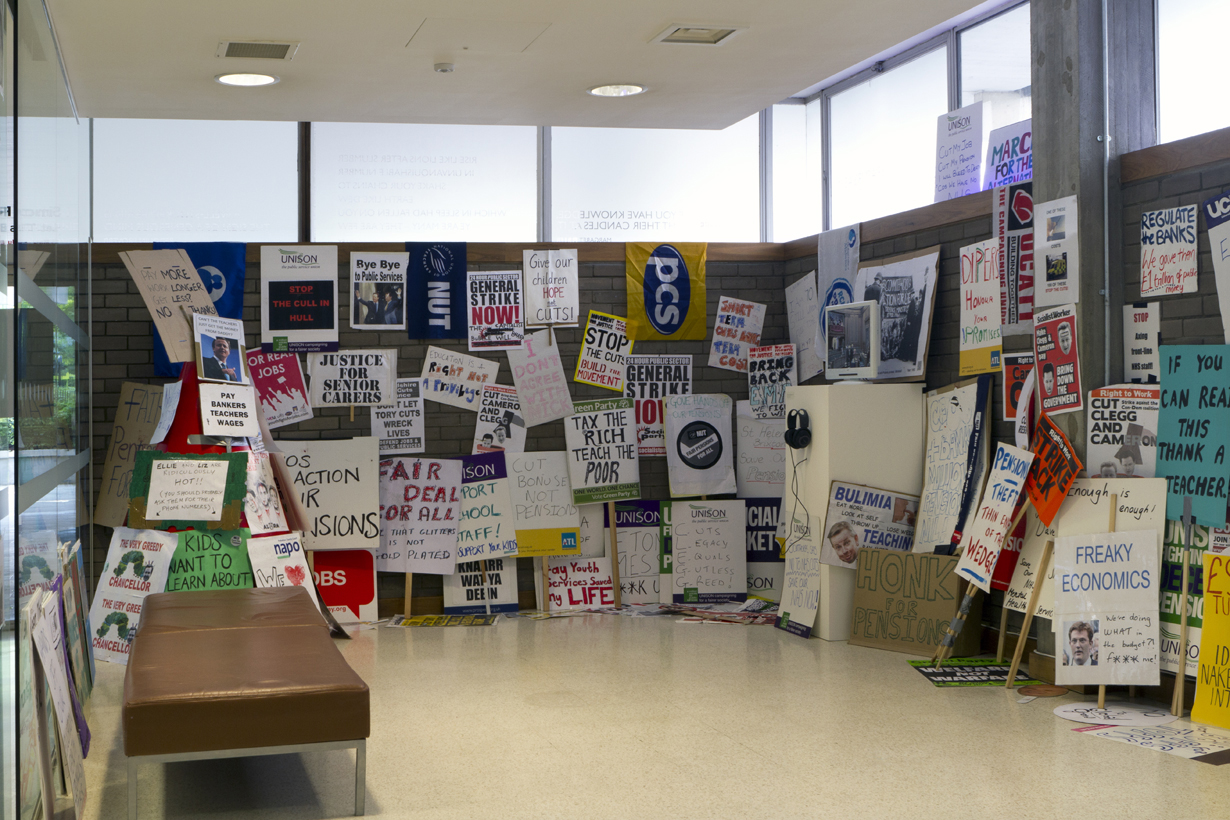
Here is the exhibition text:
One of the ways we remember an economic crisis is through its images. When we recall Depression-era America, we think of the black-and-white portraits of men in bread lines wearing placards that beg for work. Recalling Thatcher’s Britain, we see news pictures of the miners’ strike or stolen moments from the inside of dole offices. While barely a day goes by without more grim economic news, the current recession has been largely invisible, perhaps due to the challenges of representing abstract monetary systems or because the outward signs of today’s economic struggles are hard to capture without resorting to cliché, even though the eventual effects – a lost job, a vanishing pension, cut backs to social services – are intensely personal and painful.
Over the past eighteen months Simon Roberts, who was commissioned as the official Election Artist by the House of Commons in 2010, has attempted to cut through the statistics and abstractions to explore different ways of representing the effects of these changes on the landscape. In this new series of work he follows in the humanist tradition – employed by some of the most influential British documentary photographers of the last century – whilst incorporating the signs, iconography and language that have become so much a part of this ‘era of austerity’.
His approach is multi-disciplinary, using video, text and objects such as protest banners, as well as digital collages, in an attempt to record our new predicament. The Credit Crunch Lexicon, for example, is a text-based work, which draws upon the diversity of economic, political and philosophical terminology that has now become part of our vernacular. Arranged alphabetically to create a form of concrete poetry, the words and phrases scrutinize the miasma of rhetoric, hyperbole and, sometimes contradictory terms used to describe the credit crunch. In other pieces Roberts captures the more visible manifestations of economic change, from the omnipresent sales signs in shop windows and shuttered high street stores to the increase in union strikes, student sit-ins and the manifestation of the Occupy encampments which focused its protest against corporate greed. There are photographs, too, taken inside city halls around the country, where the 2011/12 annual budgets were agreed and major cuts signed off.
This exhibition aims to convey a multitude of voices and provide an incisive depiction of contemporary British reality. Our means of organising protests and campaigns may have become more technologically sophisticated, but our means of self-expression: camps, banners, graffiti remains straightforward, rooted as they are in our personal experience, our sense of justice, our vulnerability and our expectations of those in positions of power.
As is common in his practice, Roberts has added a collaborative element to this exhibition encouraging public participation.
As the new financial year progresses with continued chaos in the Eurozone and recovery slower than predicted, there is no guarantee that the fiscal landscape will improve. In this sense, Roberts’ work is unresolved. The installation is ongoing, mutable and subject to all of our fears and desires.
A colour newspaper, conceived and published by Roberts, will be available during the exhibition.
Embracing the spirit of patriotism accompanying the upcoming Olympics and the Queen’s Diamond Jubilee, The Great British Public will present images from photographers working the length and breadth of the British Isles documenting the daily life, work and rituals of the British in their many incarnations. A focus on street photography will be complimented by intimate documentary studies and portraits from a range of established practitioners including John Angerson, Nick Cunard, Peter Dench, Liz Hingley, Zed Nelson, Martin Parr, Ben Roberts, Simon Roberts, Arnhel de Serra, Chris Steele-Perkins, Ewen Spencer, Homer Sykes and Giulietta Verdon-Roe. This multidisciplinary exhibition will celebrate the extremes and quirks of life on our islands; from military funeral parades to centenarians; from pomp and pageantry to cottage industries; from Hackney in London to the most northernmost island of Orkney in Scotland, via New Brighton, the Black Country and beyond—all explored through print and multimedia in a large-scale exhibition across two sites, Dog Eared Gallery and St Pancras International.
You can view a slideshow of photographs featured in the exhibition on Time Magazine website here.
In conjunction with the exhibition:
The Great British Public Talk
Central St Martins, 25 June, 7 to 9.30pm
Join Chris Steele-Perkins, Homer Sykes, Peter Dench and Liz Hingley for a fascinating and lively discussion about the work they have on show in The Great British Public exhibition, their creative influences and their experiences photographing the British. Each photographer will present his or her work and discuss it within the context of the show, followed by a Q&A session. More information on how to book can be found here.
Mary Jane Opie, Self portrait as a huntsman, 2005 (100 x 150 cm)
THE ENGLISH WAY Curated by Craig Patrick Edwards and Derek Curtis
The Aubin Gallery is pleased to present: The English Way, an exhibition uniting six artists – Claire Clutterbuck, Dmitri Galitzine, Mary Jane Opie, Simon Roberts, Andy Sewell and Kraig Wilson – all with an interest in our national identity, and the English countryside – who are questioning what it means to be English in the 21st century.
More information about the opening night here.
The United Kingdom is slowly dissolving, with both the impending Scottish referendum on independence – and our faltering position within Europe – causing national discomfort. The emergence of the coalition government is symptomatic of the fact that trusted left-right structures; represented by Conservative and Labour politicians, no longer seem relevant.
Where does this political dilemma leave our collective sense of English national identity? This theme of political uncertainty is captured in award-winning photographer Simon Roberts’ 2011 three-channel video: Landscapes of Innocence & Experience – to be shown in London for journey across the UK during the official four-week campaigning period for the 2010 general election.
Another aspect of our national identity lies in the backdrop to our lives; our landscape. For city-dwellers, the countryside represents quintessential Britishness – but this is primarily constructed through imagery – in fine art, film, television or photography. Consequently, real rural England remains something of a mystery…
Andy Sewell, described by Martin Parr as “a photographer likely to make his mark on the future of photography”, explores stereotypes associated with the countryside. Enamoured with quaintly-named villages – Sewell searches a map to find poetic place names such as: ‘Cold Christmas’, ‘Nasty’, ‘Little Gidding’, ‘Good Easter’ – then travels to these destinations and photographs what he finds there.
The English Way will offer six varying interpretations of England, by six artists, who will each reveal what it means – to them – to be English.